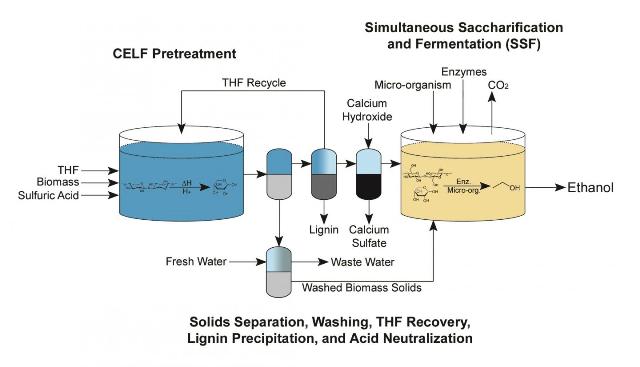Feb 25 2015
Researchers at the University of California, Riverside have invented a novel pretreatment technology that could cut the cost of biofuels production by about 30 percent or more by dramatically reducing the amount of enzymes needed to breakdown the raw materials that form biofuels.
 This is a diagram of a proposed biomass conversion process that integrates CELF pretreatment with Simultaneous Saccharification Fermentation to produce ethanol. (Credit: UC Riverside)
This is a diagram of a proposed biomass conversion process that integrates CELF pretreatment with Simultaneous Saccharification Fermentation to produce ethanol. (Credit: UC Riverside)
As partners in the BioEnergy Science Center (BESC), the team from the Bourns College of Engineering Department of Chemical and Environmental Engineering and Center for Environmental Research and Technology (CE-CERT) have shown that this new operation called Co-solvent Enhanced Lignocellulosic Fractionation (CELF) could eliminate about 90 percent of the enzymes needed for biological conversion of lignocellulosic biomass to fuels compared to prior practice. This development could mean reducing enzyme costs from about $1 per gallon of ethanol to about 10 cents or less.
The BioEnergy Science Center is a U.S. Department of Energy Bioenergy Research Center focused on enhancing science and technology to reduce the cost of biomass conversion through support by the Office of Biological and Environmental Research in the Department of Energy Office of Science..
"As recent months have shown, petroleum prices are inherently unstable and will likely return to high prices soon as expensive sources are taken off line," said Professor Charles Wyman, the Ford Motor Company Chair in Environmental Engineering at UC Riverside. "We have created a transformative technology that has the potential to make biofuels an economic sustainable alternative to petroleum-based fuels."
The findings by Wyman's research group were outlined in a just published paper, "Co-solvent Pretreatment Reduces Costly Enzyme Requirements for High Sugar and Ethanol Yields from Lignocellulosic Biomass," in the journal ChemSusChem. Co-authors with Wyman are: Thanh Yen Nguyen, Charles M. Cai, and Rajeev Kumar, all of whom are students or research engineers in Wyman's lab.
Research by the Wyman team focuses on turning agricultural and forestry residues and other non-edible plant matter, known as lignocellulosic biomass, into liquid transportation fuels. Lignocellulosic biomass is attractive because it is sustainable and abundant and inexpensive compared to oil. For example, lignocellulosic biomass costing about $60?a dry ton is equivalent in unit energy costs to oil at about $20?barrel. (Oil is currently selling for about $55 a barrel but has hovered around the $100 per barrel mark in recent years.) The challenge is to lower the cost of processing low cost biomass sources into fuels.
Lignocellulosic biomass is composed of hemicellulose, cellulose, and lignin, and biological processes favored for making liquid biofuels convert the hemicellulose and cellulose into sugars that can in turn be fermented into biofuels. However, the complex structure of lignocellulosic biomass makes it difficult for enzymes to release these sugars, and a pretreatment step using heat and chemicals is needed to reduce this recalcitrance enough to realize the high yields vital to economic success. The lignin left in biomass after most pretreatments presents a particular problem by impeding enzyme access to hemicellulose and cellulose, thereby hurting product yields and requiring more enzyme at a substantial cost.
CELF, the pretreatment developed at UC Riverside, solves those problems. In the ChemSusChem paper, the UC Riverside researchers outline laboratory results in which they compared the total achievable combined sugar yields between CELF pretreatment and dilute acid pretreatment, a current leading strategy, coupled with subsequent enzymatic hydrolysis in three timeframes with three levels of enzymes.
Using the dilute acid method, the sugar yield was only about 70 percent of the maximum possible after 14 days when two milligrams of enzymes were used. That percentage increased to about 85 percent in 14 days when 15 milligrams of enzymes were added.
By contrast, CELF pretreatment increased sugar yields to about 95 percent of the maximum possible regardless of whether two milligrams, five milligrams, or 15 milligrams of enzymes were added. Furthermore, the time required to reach these high yields dropped to five days when five milligrams of enzyme were used and two days when 15 milligrams of enzyme were used.
In addition to such drastic cutting of the amount and cost of enzymes needed to realize nearly theoretical sugar yields, CELF is capable of dissolving and extracting up to 90 percent of the lignin in corn stover and even more for woody biomass. After pretreatment and enzymes release of the sugars from hemicellulose and cellulose, previous process strategies have focused on burning the residual lignin, which is a low value proposition. However, lignin has promise as a resource from which to make additional high value chemicals and fuels once it is extracted and depolymerized with CELF.
"These findings are very significant because they establish a new pretreatment process that can dramatically reduce enzyme loadings and costs, thereby improving the competitiveness for biological conversion of lignocellulosic biomass to fuels," said Wyman, who has focused on understanding and advancing biofuels technologies for more than 30 years. "Understanding the mechanisms responsible for achieving these intriguing results can also suggest even more powerful paths to improving the economics of converting non-edible biomass into sustainable fuels."